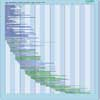| Instrument | Status/
Accuracy | Instrument Description | Measurement Technology | Timeline |
| ATLAS | Operational | Provide date on ice sheet height and sea ice thickness, land altitude, aerosol height distributions, cloud height and boundary layer height. | n/a |  |
| C-Band SAR | Operational | Marine core services, land monitoring and emergency services. Monitoring sea ice zones and arctic environment. Surveillance of marine environment, monitoring land surface motion risks, mapping of land surfaces (forest, water and soil, agriculture), mapping in support of humanitarian aid in crisis situations. | n/a |  |
| Hyperspectral Detector | Operational | Detect and measure vegetation biomass, atmospheric aerosol and chlorophyll fluorescence, and can also obtain the remote-sensing information of global forest carbon sinks. | n/a |  |
| Laser Radar | Operational | Detect and measure vegetation biomass, atmospheric aerosol and chlorophyll fluorescence, and can also obtain the remote-sensing information of global forest carbon sinks. | n/a |  |
| MERSI-2 | Operational | Measurement of vegetation indexes and ocean colour. | n/a |  |
| MERSI-3 | Operational | Measurement of vegetation indexes and ocean colour. | n/a |  |
| MERSI-RM | Operational | Measurement of vegetation indexes and ocean colour. | n/a |  |
| OLI | Operational | Measures surface radiance, land cover state, and change (e.g., vegetation type). Used as multi-purpose imagery for land applications. | n/a |  |
| OLI-2 | Operational | Measures surface radiance, land cover state, and change (e.g., vegetation type). Used as multi-purpose imagery for land applications. | n/a |  |
| PALSAR-2 | Operational | Disaster monitoring, land monitoring, agricultural monitoring, natural resource exploration, global forest monitoring, potential use and interferometry. | n/a |  |
| PALSAR-3 | Operational | Disaster monitoring, land monitoring, agricultural monitoring, natural resource exploration, global forest monitoring, potential use and interferometry. | n/a |  |
| SAR (RADARSAT-2) | Operational | All-weather images of ocean, ice and land surfaces. Used for monitoring of coastal zones, polar ice, sea ice, sea state, geological features, vegetation and land surface processes. | n/a |  |
| SAR (RCM) | Operational | All-weather, C-band data to support ecosystem monitoring, maritime surveillance and disaster management. | n/a |  |
| SAR-L | Operational | Land, ocean, emergencies, soil moisture, interferometry, others. | n/a |  |
| S-band SAR | Operational | SAR imagery for a range of applications including agriculture, maritime and forestry | n/a |  |
| MOLI Imager | Being developed | | n/a |  |
| MOLI Lidar | Being developed | | n/a |  |
| P-Band SAR | Being developed | Forest biomass monitoring. Products are Forest Above Ground Biomass, Forest height and Forest Distrubance. | n/a |  |
| S-band SAR (NISAR) | Being developed | 3-year mission to study solid earth deformation (earthquakes, volcanoes, landslides), changes in ice (glaciers, sea ice) and changes in vegetation biomass | n/a |  |
| SGR-ReSI-Z | Being developed +/-20 % | Ocean winds, waves, soil moisture, flooding, freeze / thaw state over permafrost, biomass, ice, snow | n/a |  |
| CLIM | Approved | 3-band cloud pushbroom imager for detecting low and high clouds in the spatial sample of CO2I allowing to remove these data from the retrieval process. | n/a |  |
| HSI | Approved | Pushbroom-type grating Imaging Spectrometer with high Signal-to-noise Ratio and data uniformity to derive quantitative surface characteristics supporting the monitoring, implementation and improvement of a range of policies in the domain of raw materials, agriculture, soils, food security, biodiversity, environmental degradation and hazards, inland and coastal waters, snow, forestry and the urban environment | n/a |  |
| L-Band SAR | Approved | L-band SAR instrument offering full polarimetry, high spatial resolution, high sensitivity, low ambiguity ratios and capability for repeat-pass & single-pass cross-track interferometry to measure surface deformation of vegetated terrain, soil moisture, land cover classification, crop type discrimination and its temporal analysis. Furthermore, it will monitor Polar ice sheets and ice caps, and the sea-ice conditions (i.e. type, drift, deformation, concentration, lead fraction), as well as contribute to the European maritime situational awareness. | n/a |  |
| L-band SAR (NISAR) | Approved | 3-year mission to study solid earth deformation (earthquakes, volcanoes, landslides), changes in ice (glaciers, sea ice) and changes in vegetation biomass | n/a |  |
| LandIS | Proposed | Measures surface radiance, land cover state and change (e.g., vegetation type), and longwave termal infrared surface emittance. Used as multi-purpose imagery for land applications. | n/a |  |
| L-Band SAR | Proposed | Global observation of dynamic processes in the bio-, cryo-, geo- and hydrosphere. | n/a |  |
| GEDI | No longer operational | This project will use a laser-based system to study a range of climates, including the observation of the forest canopy structure over the tropics, and the tundra in high northern latitudes. The instrument was placed into storage on the ISS on March 17, 2023, where it is expected to remain for 13-18 months, before continuing operations from 2024. | n/a |  |